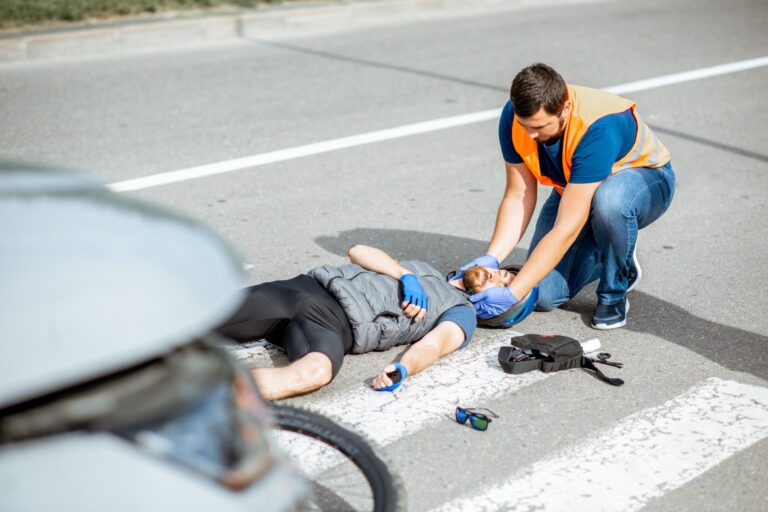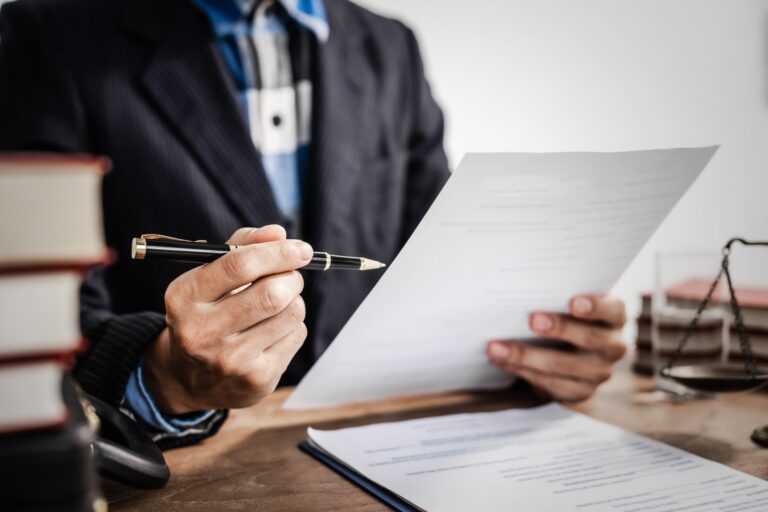Pedestrian Accidents
Get legal help to protect vulnerable parties
Pedestrians are the most vulnerable party in a traffic accident. Their injuries may range from lacerations and broken bones to severe head injuries and loss of limbs. If you are the victim of a pedestrian traffic accident, you may be eligible for compensation for the damages you have suffered.
Pedestrian accidents are caused by many different things – the most common being:
- Distracted driving
- Distracted walking
- Speeding
- Driving while intoxicated
- Broken or missing traffic signals
Did you know: pedestrian accidents are the 2nd-highest number of road fatalities?
In 2022, 109 pedestrians were killed in traffic crashes in Colorado. The rates of pedestrian deaths in motor vehicle crashes are highest for people ages 20-69, followed closely by children younger than 10.

Who is at fault in a pedestrian accident?
A driver is not always liable for an accident at an intersection. Many people are unaware of just how right-of-way laws work. In many cases, the driver or the pedestrian thinks they always have the right-of-way, which is not true.
It can be the motor vehicle driver, the pedestrian, or both who could be at fault when pedestrian accidents happen.
While drivers may be found liable for injuries caused by an error they committed while using the road, they are not always liable for hitting a pedestrian. In general, pedestrians are considered to be at fault when they miscalculated their actions, lost control (for example, by tripping), or committed an error such as failing to yield the right-of-way to vehicles and drivers who fail to see them.
Keep in mind that the term “pedestrian” can also apply to users of non-motorized modes of transportation on a public roadway, such as a bicycle, scooter, skateboard, rollerblades, skates, etc. A pedestrian, therefore, may be a person running, biking, skating, etc.
Common causes of pedestrian accidents
Either the driver or the pedestrian may have failed to observe traffic rules and regulations due to:
- Distracted driving: for example, because they were texting, eating, talking with passengers, changing the radio station, daydreaming, etc.
- Distracted walking: for example, because they were texting, reading, listening to music, etc.
- Distracted biking
- Driving while intoxicated
- Bad weather
- Marijuana consumption. Since legalizing the recreational use of marijuana in 2012, Colorado has seen a 12% increase in pedestrian fatalities.
- Speeding
- Driving while fatigued
- Dangerous roadways: for example, because of closed-off sidewalks due to construction, a lack of sidewalks, etc.
- Broken or missing traffic signals
Colorado pedestrian laws
Traffic signs and signals tell both drivers and pedestrians what to do. Just like drivers, pedestrians must obey them, too. Pedestrians do, however, have the right-of-way in a crosswalk regardless of whether it is marked (i.e., white lines) or unmarked (i.e., an intersection). They have priority over all other vehicles, including bicycles, motorcycles, and emergency vehicles. Cars must come to a full stop and wait for pedestrians to cross an intersection, even if the driver can go around them.
Additionally, drivers making a turn must yield the right-of-way to any pedestrians who are within 30 feet of the intersection. Finally, a driver turning into a driveway or parking lot must yield to pedestrians who are already on the sidewalk or path. The driver must also yield to pedestrians who are about to enter the driveway or parking lot. As for pedestrians, they must wait for the walk signal to change in their favor, and must always look both ways before crossing. If a pedestrian crosses against the walk signal, they could be liable for their own injuries.

What is vehicular manslaughter?
Vehicular manslaughter occurs when someone causes another’s death through reckless driving. Recklessness involves a conscious disregard of significant risks, deviating grossly from reasonable behavior. If you’re involved in a fatal accident, you might face these charges, but avoiding them depends on the circumstances and proving that you knowingly created a substantial risk of harm. Consult an experienced attorney immediately if accused; they can help defend against the charges and navigate the legal complexities.

Pedestrian responsibilities & shared liability in accidents
Just like drivers, pedestrians have certain responsibilities, including the responsibility to use sidewalks and crossings safely. In case of an accident, the driver’s attorneys may try to show that the pedestrian was negligent—i.e. they ignored their responsibilities and were at fault. If, for example, you are a driver and crash as a result of swerving to avoid a pedestrian who ignored a red light and walked in the path of your car, you can seek compensation for your damages.
If this strategy is successful, then the court may decide on shared liability according to the comparative negligence rule. In such cases, the pedestrian is considered partially negligent or responsible for the accident. If their negligence is estimated to exceed 50%, they may be refused compensation for the accident. Indeed, they may even end up having to compensate the other party if they are found to be fully liable for the accident.
A typical example of shared liability is if the accident happened while you were trying to cross the street in an area where the driver had right of way. Other common examples of potential pedestrian liability include walking on a high-speed road where no pedestrians are allowed, not respecting traffic lights, and walking on the right side of a rural road instead of the left side as the law states.
Proving the at-fault driver was negligent
Accidents involving pedestrians often occur because either or both of the parties failed to respect the right of way. Since pedestrians have the right-of-way at all intersections and crosswalks, it is perhaps unsurprising that only 18% of pedestrian deaths take place in intersections nationwide.
Unfortunately, drivers are often negligent in following the law. Just like the driver’s lawyer may try to prove that the pedestrian was negligent, the pedestrian’s attorney will have to prove that the driver was negligent. The attorney will also have to prove that the driver’s negligence resulted in the pedestrian’s personal injury—i.e. the injury was not preexisting or due to another factor.
In some cases, this is simple. If, for example, the pedestrian was hit by a car while crossing a crosswalk and had shown care by looking both ways before crossing, it is much easier to establish the driver’s liability. Unfortunately, this is not always the case.
That is where a police report and the evidence the pedestrian collected at the scene of the accident becomes invaluable. For example, establishing the driver’s liability is much easier if the police report documents that the driver was driving under the influence of alcohol or other substances at the time of the accident. The driver may also have been distracted by their mobile phone or other distraction, or they may have been speeding over the established speed limit. Finally, they may have failed to completely stop before a crosswalk to allow the pedestrian to cross at the crosswalk. All this information can be found in the police report or by talking to witnesses.
It is also important that the pedestrian has gone to the hospital following an injury, and that they have kept all receipts and medical information. One further complication arises from the fact that not all injuries are immediately noticeable. For example, a pedestrian may realize they have suffered an injury days after the accident.
Making sure that all the necessary information has been collected can be hard at the stressful time following an accident. That is why you should contact an experienced lawyer right away. Your attorney will guide you as to your next steps and ensure you have all the information you may need. Hiring a pedestrian traffic accident lawyer early will maximize your chances of filing a successful compensation claim.
An experienced traffic accident attorney can make all the difference between receiving the amount of compensation you deserve and very little—or none at all. Not only will an experienced lawyer help you collect all necessary evidence and protect you from any oversights, but they will also prepare your claim, thus letting you focus on the most important thing: recovering from the accident. Additionally, your attorney can advise you on the damages you can claim and handle communication and negotiation with insurance companies on your behalf. If necessary, an experienced pedestrian accident attorney will also argue against comparative negligence in court.
State & federal safety programs
for pedestrian accidents
The rise in pedestrian accidents has been noticed by both state and federal authorities, who have been trying to combat their causes using a number of grants and programs.
On a state level, the need to educate both pedestrians and drivers is clear, as Colorado has the fifth-highest percentage of pedestrian deaths that take place in intersections, reaching 29% (compared to 18% nationwide) [5]. Colorado supports four grants specific to pedestrian education, awareness, and enforcement. Additionally, the Office of Communications creates public relations materials and campaigns related to pedestrian education.
The State and Community Highway Safety Grant Program provides the states with the resources they need to meet their most pressing needs.
Since 2004, the Safety Office of the Federal Highway Administration (FHWA) has provided the cities and states with the highest pedestrian fatalities and/or fatality rates with extra resources in an effort to reduce pedestrian deaths. Part of this effort has included the How to Develop a Pedestrian Safety Action Plan, which helps state and local officials address pedestrian safety issues.
Since 2017, approximately $14 million has been awarded to eligible states annually to decrease pedestrian crash fatalities. The states may use the funds to train law enforcement officials on pedestrian traffic laws, for pedestrian safety enforcement of these laws, and for education campaigns promoting pedestrian traffic laws.
This program aims at a significant reduction in traffic fatalities and serious injuries on all public roads through engineering countermeasures.
Knowledgeable. Compassionate. Dedicated.
We are your personal injury team.
Available 24/7 to take your call: (720) 743-3682